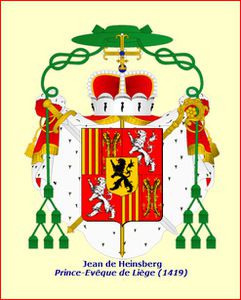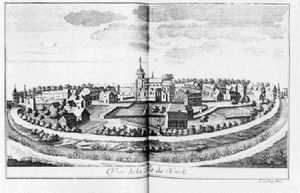Jean de Heinsberg et le grand brûlé (Dgs 669)
Historique: Jean de Heinsberg
Né en 1397 du comte Jean de Heinsberg et de Marguerite de Genappe. Il est archidiacre de Hesbaye quand à 23 ans, il est élu le 16 juin 1419, prince-évêque de Liège. Il est confirmé à sa charge le 10 septembre 1419 par le pape Martin V. Il participe à la croisade contre les hussites (Jean Hus précurseur du protestantisme) en 1420. Le 14 juillet 1430, Jean de Heinsberg déclare la guerre au duc de Bourgogne Philippe le Bon, qui avait acheté le comté de Namur. Le château de Poilvache (comté de Namur) tombe et est démoli. Philippe le Bon hérite du Brabant et devient duc de Brabant et de Limbourg. La principauté de Liège est cernée et le prince-évêque signe une paix défavorable (traité de Malines) le 15 décembre 1430. Le 31 mars 1455, Philippe le Bon impose l’abdication de Jean de Heinsberg, car il désire placer un membre de sa famille à la tête de la principauté de Liège. Le pape Calixte III confère le siège épiscopal à Louis de Bourbon le 30 mars 1456. Jean de Heinsberg meurt au château de Curange le 18 octobre 1459.
Born in 1397 from count John of Heinsberg and Marguerite of Genappe. It is Archdeacon of Hesbaye when at age 23, he was elected on 16 June 1419, prince-Bishop of Liège. It is confirmed to his charge on 10 September 1419 by Pope Martin v. He participated in the crusade against the hussites (Jean Hus precursor of Protestantism) in 1420. On 14 July 1430, Jean de Heinsberg declares war on the Duke of Burgundy Philip the good, who had bought the County of Namur. The castle of Poilvache (County of Namur) fell and was demolished. Philip the good inherits from Brabant and became Duke of Brabant and Limburg. The Principality of Liège is surrounded and the prince-Bishop sign an unfavorable peace (Treaty of Malines) December 15, 1430. On 31 March 1455, Philippe the good necessary the abdication of Jean de Heinsberg, because it wishes to place a member of his family at the head of the bishopric of Liège. Pope Callixtus III gives the bishopric of Liège in Bourbon Louis March 30, 1456. Jean de Heinsberg died at the castle of Curange October 18, 1459.
Grand brûlé (Dengis 669, de Chestret 333)
Historique: Grand brûlé
Ce grand brûlé est forgé à Hasselt. Ce type de brûlé au perron en billon noir de Jean de Heinsberg est aussi produit à Liège, Weert et Herck-la-Ville. (Herck-la-Ville est une des 23 Bonnes-Villes de la principauté de Liège dans le comté de Looz. Son atelier monétaire sera en fonction 30 ans, de 1389 à 1419).
This grand brûlé is forged in Hasselt. The type of burnt to a perron in black billon is also produced in Liège, Weert and Herk-la-Ville. (Herk-la-Ville is one of 23 Bonne-Ville of the Principality of Liège in the County of Looz. Will his monetary workshop be function 29 years, from 1389 to 1418).
Description: Grand brûlé
Avers : Une croix pattée traversant la légende et ayant au milieu les armoiries de Jean de Heinsberg.
Obverse : The cross crossing the legend and in the Middle the arms of Jean de Heinsberg.
Revers : Un perron sur trois degrés.
Reverse : The perron.
Diamètre : 23,0 à 25,0 mm
Diameter : 23.0 to 25.0 mm
Poids : 0.89 à 2.69 gr
Weight : 0.89 to 2.69 gr
Axe : Divers
Axis : various
Métal : Billon noir
Metal : Billon black
Degré de rareté : Commun
Degree of rarity : Common
Cotation 2010, valeur conjecturée : 40€
Herck-la-Ville




